The Polish Army In France & 2DSP Internment in Switzerland 1939 – 1940
As Europe slipped towards war, numerous Polish émigrés working in France found themselves trapped between the need to
work and maintain their normal lives or watch their country obliterated so soon after regaining independence. Poland and France had
been culturally linked since Napoleonic times and during the 1920s and 1930s France had received many émigrés who either worked
in the coalmines of northern France or in the factories located in major cities throughout France. As war neared many felt a ‘calling’ to
defend an independent Poland. See Operation Monika/POWN.
The gates reopen at Coétquidan in Bretagne, northern France for the first recruits. Described by Piotowski (1943:45) as
‘a gloomy place - flimsy, wooden barracks built at the time of the last war by the American Army’.
Dressed in old horizon blue and capped with oversized navy blue berets from the quartermasters’ stores of the previous war and
without weapons, the volunteers despite very different backgrounds were resilient and ready to defend France and Europe.
Those
with an education to degree level were put into an officer’s cadre and former combatants assisted in all ranks the development of their
duties according to rank including the revival of marching songs of the Pilsudski’s Legion or the nationalistic anthem
Boze cos Polske.
Lack of equipment, arms to train with and even proper washing facilities did not deter the idealistic of the volunteers. Colonel
Grzedinski commanded the camp prior to the camp being moved south into the Lorraine near Colombey-les-Belles, southwest of
Nancy when it was taken over by General Bronislaw Duch and renamed the 1st Grenadier Division in honour of the Poles who
fought under Napoleon. Only 8% of the troops were émigrés volunteers and the Division was largely made up of escaped army
personnel who all had adventures to tell. The 1st Regiment was commanded by Colonel Lowczowski and the 2nd Regiment by
Colonel Zientkiewicz. The Polish Army had been organized prior to 1939 upon a French concept, so by chance was able to integrate
quickly into the French command structure. The 1st Regiment was sent to Wittlesburg - the gap in the Maginot Line of
some 20 Km.
The Finish Project
The Finish Project
In early February 1942 the French government proposed to Sikorski that ‘surplus’ Poles based at Coétquidan in Bretagne, could be trained, and seconded to Finland to bolster their defences despite his objections (TNA HS4-162). In a report by Major General Beaumont-Nesbitt on 16th February 1940 that after a meeting with Colonel Kenzidor, the Polish Chief of Staff, he concluded the Poles were half trained, poorly equipped and not ready to be placed in this kind of theatre of war. The French had requested the Poles to provide two Infantry Divisions, artillery units and an armoured unit with accompanying engineer and signals units making a total of 9,000 men committed to the project (TNA HS4-162). Sikorski’s ‘aide memoire’ indicated the French would deplete the Polish forces especially the non-commissioned officers based in France to a point where the remaining military personnel and units would no longer be viable. This point was considered By General Gamelin, Chief Command of Forces Terrestres. General Ironside, the C.I.G.S and Sir Ronald Campbell having informed the War Office now placed pressure upon the French to drop the project.
The following document confirms the state of the Polish Forces on 20th February 1940. Colonel Kenzidor visited Coétquidan in early March and again found the Poles unprepared for the Finnish project. By May 1940 the Podhale Rifle Brigade were requested to be sent to Norway with the Expeditionary Force with the plans for Finland quietly dropped. Norwegian Campaign
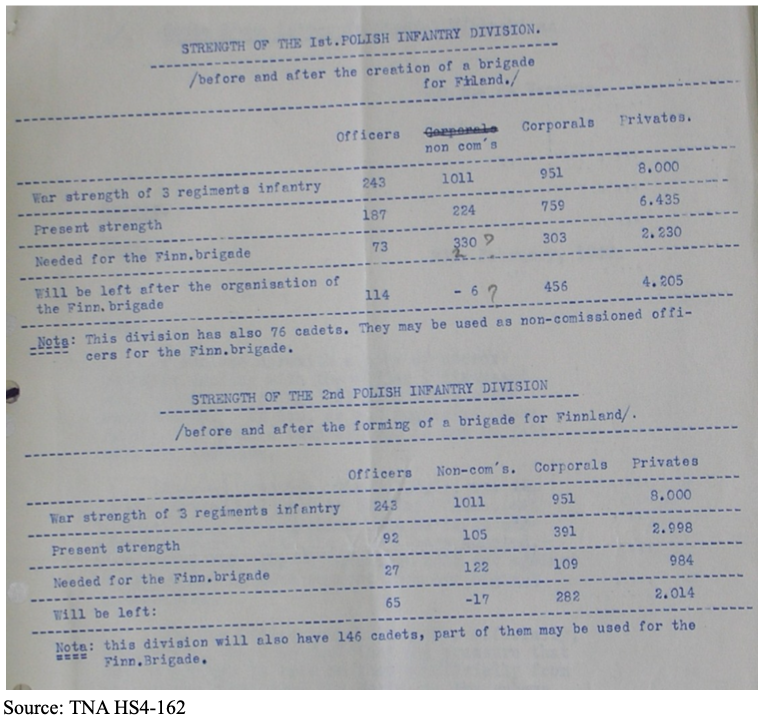
Colonel Kedzior formally reported to Lt. Col. Gubbins that the continued pressure from the French would undermine all plans Poles had for an exiled army where the embarkation palnned for 29th February was not realistic. By 21st February General Denain had written to General Gamelin confirming that the Poles would not be ready for embarkation in mid-April nor May. The French continued to put pressure on the Poles who confirmed that by mid-March 1940 only one company of tanks and one company of signals were ready. The lack of senior N.C.O’s undermined the viability of the force.
The 2nd Division (2DSP) was based between late December 1939 and May 1940 at Parthenay in France. Commanded by Brigadier-General Prugar-Ketling the division was encharged with the defences around Belfort from early June 1940 where on 1st June they were sent to Colombes-les-Belles as part of the French 8th Army. The 3rd and 4th Infantry Divisions were still being formed when France capitulated. It was hoped by the Polish officers that the 2DSP would fight along side 1st Grenadier Division as ‘brothers at arms’, unfortunately the French High Command had alternative plans.
2DSP were transported from Parthenay on 19th May via Airvault and St. Loups a la Ferriére. On 1st June they were stationed at Colombey les Belles just 25Km from Nancy where the soldiers noticed the local population were friendlier towards them. The troops were deployed in Lower Lorraine and ordered to complete the journey on foot. The 110Km march to Belfort was made in four stages. The journey was difficult and ill fitting boots and poor physical conditions took its toll on the inexperienced soldiers. Equipment was placed on cars and lorries with the final stage of the march taking place in the cooler conditions of the night. Now under the overall command of the 3rd French Army, the Poles began to construct anti-tank batteries with the battalion of engineers arriving from Angers to assist in their construction. There were discussions of moving the artillery division to the Maginot Line assuming this was the point of intended attack.

|

|
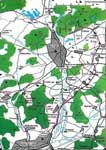
|
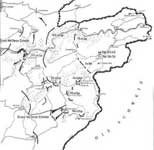
|
The Final Stand
Source: Fondation Archivum Helveto-Polincium (2000)
|
On 8th June at 21.00 there was a suddenly a new set of commands from the French Army. The 2DSP were being integrated with the French 45th Corps under the command of General Darius Daille to re-enforce the Eastern flank in response to the German invasion of France under operation Der Fall Braun. On 9th June orders were received to embark on troop trains located in Vesoul. On 10th June the orders confirmed they were being sent to re-enforce Belfort and loading commenced at 14.00 and was not completed until 18.30 on 13th June. Witnesses described the embarkation as chaotic and lacking overall cohesion with officers having to deal with partial or incomplete plans which complicated the loading (Smolinski, 1992). The first units of the division were disembarked at the railway stations in Belfort, Montbeliard, Lure, Bas-Evette, Hericourt and Morvillars. The disembarkation started on 10th June 14.30 until 16.00 on 13th June into a region where the Poles felt the local population were not welcoming. The 2DSP were quartered in poor conditions with some living in the forests. After the first Luftwaffe attacks on Belfort, the following strikes were aimed at damaging or destroying artillery locations around the city. For two days there were conflicting reports and orders. General Daille confirmed the 2DSP were to spend two days of training and then four days building fortifications around the city. The Polish troops remained disciplined and tidy in appearance and soon won over the local people who were less impressed by the organization of the French forces (Smolinski, 1992) whom the local population nick-named ‘salauds’ or rascals.
General Daille under pressure from the French General-Staff continued to strengthen fortifications around the city and ignored intelligence reports that the attack would be from the northeast where 25 German Divisions were amassed ready to strike. The 2DSP were tasked to build or strengthen the defences around Belfort where four days were devoted to building and two days for training. General Daille was convinced the massed German forces was an exaggeration and that General Laure had over stated the concentration of the opposing forces.
Brigadier-General Prugar-Ketling received first orders on 12th June. The artillery division and the infantry were to be held in reserve (szab polku piechoty). For the next twenty-four hours more questions than answers were raised as the role of the 2DSP appeared vague in terms of role and under whose command they would receive their orders for deployment. By 13th June clarity in role became clearer as the orders were received at 15.00 ordering 2DSP into defensive roles on a north-south axis under the overall command of the French commander General Girol. On night of 13th and 14th June General Pruger-Ketling gave his orders for the 2DSP to take up positions. The northern sector consisting of the 5th Little Poland Infantry Regiment (Malopolski Pulk Strzelcow Pieszych) was to be commanded by Colonel Bronislaw Kowalczewski who also had two French Pioneers Divisions on the line. The southern sector was defended by Lt. Colonel Aleksander Gembal who commanded 4th Warsaw Infantry Regiment (Pulk Strzelców Pieszych) and their task was prepare to counter-attack in the direction of Bouogne.
General Prugar-Ketling’s initiative was undermined when General Daille succumbed to an order from the French Chief of Staff. The two battalions of French pioneers were withdrawn. 2DSP were now defending the north and eastern approaches to Belfort on an inverted ‘L shaped’ arc line from Seromagny - Lachappelle sous Rougemont down to Fesches le Chatel - Arcey thereby rendering the Eastern defences useless. On 10.00 14th June 1940 the German 444th Infantry Regiment crossed the Rhine at Colmar. The French General Staff still considered the main threat to Belfort from the east between the Swiss - German Border.
On 15th June the main German attack came northeast from Vesoul and Gray. As the attack was launched, the 6th Infantry Regiment (6 Pulk Piechoty) received orders to hold their eastern positions while half an hour later in the confusion of battle unit commanders received orders to swing their defences to the west. Confusion continued for the next twenty-four hours.
On 16th June at 06.30 General Pruger-Ketling enforced closure of the roads Hericourt – Belfort and Frahier et Chatebier – Belfort. At 07.00 an order was given for an infantry battalion consisting of three battalions from the 6th Infantry Regiment and one from the 4th Infantry Regiment together with three artillery divisions to stay and defend Belfort while the rest of the division should march south in the direction of Besancon to keep open a route for the main forces from the west. General Pruger-Ketling disliked the order to fragment and dismember the division and waste valuable time removing troops from the line who were needed to defend Belfort (Smolinski, 1992). Pruger-Ketling recommended a counter-attack to the east by the whole division (without the 5th Regiment and reconnaissance division). Although Prugar-Ketling’s alternative proposition was accepted, nothing materialized. Orders came for the 2DSP to march south towards Rioz. The size of the column including the 116th Heavy Artillery made the plan a potential massacre, as the troops were an easy target for the Luftwaffe.
As the situation deteriorated, General Daille ordered the 2DSP south towards Besancon during the night of 16th/ 17th June in two columns. All roads in the Hericourt-Belfort and Frahier-Belfort to be closed. Three battalions from the 6th Regiment and one battalion from the 4th Regiment plus three artillery divisions were left to defend Belfort. All other units were ordered south to Besancon.
Panzer Divisions’ under the command of General Heinz Guderian were attempting to strike through the retreating columns. Directed from Guderian’s HQ based in Langres, the situation for the retreating columns became increasingly tenuous. Despite physical exhaustion the 2DSP arrived at Pont de Roide and hid in the in the forests surrounding the village. The 6th Infantry Regiment (6 Pulk Piechoty) were given separate orders to move and defend the bridge at Colombier Fontaine, at that time a key bridge needed to remain intact for the eastward advance. As the German units advanced isolated units, for example, the 6th Company of the 4th Regiment stationed at La Roche du Prêtre were taken prisoner.
By the 17th June the ‘pocket’ was shrinking close towards the Swiss border with units of the 2DSP defending the town of Maîche while Marshall Pétain declared an armistice. In the confusion of the armistice being announced, a number of troops within the 6th Company under the command of Lieutenant Zdzislaw Baranicki surrendered while others slipped away.
For the 2DSP they were now both politically and militarily abandoned by France. The 2nd Division was placed in a defensive line from Damprichard to Trevillers in order to defend the northern Saône and secure their escape route into Switzerland. Once the advancing Panzer units had captured Gray en Haute Saone, the route to Besançon was open and Belfort defences were being outflanked. Once the German units had crossed the river Saone at Quitter 18km north of Gray, some units swung north towards the rear of Belfort. The 5th Regiment of the 2DSP held a metal bridge at Seveux, which was blown to halt the German advance. However, Germans engaged the retreating 5th Regiment at La Vaivre de Sevaux where two Polish soldiers were killed. Ordered to fallback to the north-east of Maîche they made their way eventually to Saint Hypollite through the forest which provided cover. Some units of the 5th Regiment were holding positions at Ferrieres-le-Lac further to the south.
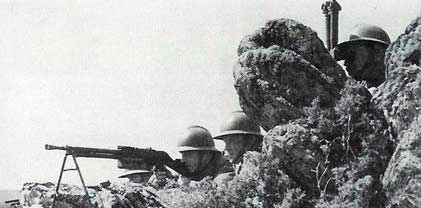
Heavy Machine Gun Unit at Clos du Doubs
With the German breakthrough in the evening of 16th June, the roads became clogged with escaping units of the French 8th Army and 45th Army Corps. Many of these units panicked and fled in disarray disposing of arms and equipment along the route. Remnants of these units set up defensive lines between the river Creuse and Reverotte. The fleeing columns were being funnelled through St. Hypollyte towards Maîche or towards Pontalier on narrow roads typical of this part of the Jura, which also constrained and frustrated the German advance.
On 17th June Polish units received orders to close the Doub valley above Bief towards Pierrefontaine les Blamont as well as the Dessoubre valley in an attempt to allow French forces to reposition close to the Swiss border at Indevillers. The 6th Infantry Regiment under the command of Lieutenant Bien was to defend the northern sector of St. Hypollite – Montandon and was joined by French Saphis units who fought hard and did not break the line. German units were penetrating through the forests towards Saint Hypollite in an attempt to outflank the Poles. The first contact with German armoured units was at 13.30 at Frambouhans to the southwest of Maîche where they attempted to break through and were halted by fierce fighting. The Saphis units eventually crumbled under the weight of the attack and the Germans began to outflank the 1st Battalion through the forests. Artillery barrages by the 1st Light Artillery Division supporting the 1st Battalion kept the attack at bay and enabled the evacuation of Maîche at 22.30. On the evening of 17th June senior officers had checked on the condition of the men and levels of ammunition. General Pruger-Ketling reported the serious deteriorating conditions to General Darius Daille who concluded that an escape to the south of France was now impossible. General Pruger-Ketling went to the front line in the forests of Clos du Doub to inspect the conditions in this sector. On returning to his HQ the plans for the mass evacuation to Switzerland were put in place for the night of 19th to 20th June.
The 6th Regiment had staunchly defended Saint Hypollite and its bridge over the River Doub in order to allow retreating units to escape east. They sustained heavy casualties after an engagement with a large formation of Panzer units with a simultaneous attack towards Pontalier. Saint Hypollite was in flames and constant artillery barrages destroyed most of the houses leaving its defensive positions in constant danger of being outflanked and over-run. 2nd Lieutenant Bien had been asked to mount the final defence of the village with an anti-tank unit supported by the 2nd Light Artillery Regiment until the morning of the 19th June in order to enable the evacuation of troops to the Swiss border. In the ‘heat of battle’ many Polish units escaped through luck and the confusion caused by thick smoke and the melee of soldiers and civilians trying to escape. The 6th Regiment had inflicted heavy losses on the Germans. As the battle died down from 17.00 onwards, the regiment was ordered to retreat. As they evacuated Saint Hypollite, they blew the bridge at Soulce and opened up the dam near Vaufrey to flood the valley in order to hamper the German advance.
The night of the 18th to 19th June was generally quiet in many sectors giving the weary troops some respite from battle. Troops regrouped themselves and took up new positions. The 2nd Battalion of 4th Infantry Regiment were ordered a night-time operation to clear up abandoned transport, horses and artillery in preparation for the German attack that included remnants of French regiments. Troops from the 67th French Infantry began to retreat through the lines of the Polish 6th Regiment causing confusion in the defences.
At 07.30 the Germans engaged the sector held by 4th Regiment. The 3rd Battalion led by Major Raczek temporarily held back the armoured units with covering artillery fire from the 2nd Light Artillery and successfully destroyed a number of tanks and armoured personnel carriers. At 09.45 the Germans intensified their attack with heavy artillery and mortars that had been brought up overnight in order to smash through the Polish defences. The 3rd Battery of the 2nd Light Artillery continued to provide an accurate blanket of fire to cover the 3rd Battalion causing the Germans to temporarily retreat and re-group. Attacking again at 13.00, the Germans came to within 300m of the defensive lines where the Poles put up a tremendous and stubborn fight causing another retreat with many casualties on both sides. At 15.00 heavy German artillery shelling attempted to smash the defensive lines in an attempt for tanks to break through the forest at Le Mont, however, a patrol of the Karasia Regiment intercepted the action and the positions were held.
On the morning of 19th June after the final and very bitter fight in the valley at Clos du Doubs the 2nd Division decided to escape across the border into Switzerland. The 4th Infantry Regiment had held the southern villages of Trevillers, Damprichard and Charmauvillers and was attacked by a major thrust by a Panzer units. The 6th Regiment had defended Saint Hypollite and its bridge over the River Doub where they had sustained heavy engagement with a large formation of Panzer units. The village was in flames destroying most of the houses. At the same time Lieutenant Gembal was left defending a line stretching through the villages of Trévillers – Indevillers – Ferrieres towards Fesserville. 2nd Lieutenant Bien who had commanded the northern flank was ordered to leave one infantry troop with anti-tank guns at Saint Hypollite. In the two-day battle the 2 DSP had held onto an 18km front denying the Germans access to key towns such as Damprichard. With munitions running low, the defending units were under intense mortar and artillery fire particularly on the northern flank of the southern sector where Major Zarzycki commanding the 2nd Battalion was in an exposed position due to the lack of artillery cover from the French forces who had abandoned the field. The 2nd Battalion endured and repulsed a counter attack by tanks at 13.00 and held the line with patrols by the Karisia platoon blocking outflanking manoeuvres. The 2nd battalion held their positions until 18.14 when they withdrew towards Fessevillers.
The Wilenski Reconnaissance Division had initially been redeployed on the morning of 15th June in region of Vesoul were they were redirected to protect the 20 km sector between Port d´Atelier – Traves. Ordered to control the strategically important road and railway bridges the task was too hard for an overstretched division. Between 22.00 and 24.00 Colonel Duluc ordered all bridges in this sector to be blown after allowing as many French refugees and soldiers to escape mostly without weapons. The following day the division became under contact with German units with the units based at Amancey under attack from mechanized units. To the north, the 2nd Battalion based in Vauvillers held a front toward Veseul using reconnaissance troops to close a gap in the Amoncourt, Fleurrey, Favorney sector. The 1st battalion were ordered to move out from the town of Conflans while the 3rd battalion should move on southern-west to St. Loup and into the forest. After sustaining casualties, the units moved back towards Vesoul with the 1st and 3rd battalions to retreat to Lure. The commander of 3rd battalion, 2nd Lieutenant Jerzy Glowacki received an order from French commander to move to Fourgerolles and then to the north of Luxeuil. Ordered to re-position themselves they arrived on 17th June to Fougerd, where they would take up position of defence with French Alpine troops supported by artillery. The French never arrived. Despite being potentially surrounded by German troops, the 5th Regiment led by Kowalczewski were ordered to make their way to Saint Hypollite. As the situation deteriorated, confusion over orders hampered the effectiveness of command. Now surrounded and in a confused state, German units ordered the surrender and capitulation, however, the officers were against this decision and ordered all units to escape in small groups towards the Swiss border using the forests as cover.
The escape route took them through: Belverne, Courmont, Saulot, Bournois, Soye, Paroisse, Vellerat, Landresse, Avoudrey, Nods, Mouthier to Salin picking up other Polish units en-route and dismissed some soldiers living in France to reduce manpower of units.
The march started on 18th June at about 16.00 and after 3 hours rested in Bournois. The Polish units regularly passed through already areas occupied by Germans and used nightfall to creep through the villages of Soye and Paroisse. During the march they engaged German units taking prisoners along the way. Some reconnaissance units were caught by German motorcycle units in Avoudrey where 20 troops were taken as prisoners, but most of them escaped to rejoin other Polish units heading for the Swiss border.
On 19th June at 15.00 the remnants of the reconnaissance units were approaching Mouthier already occupied by German infantry troops and tanks. The civil population secretly helped the Polish troops with food and also guides to the border. Lieutenant E. Swiecicki to make a decision to dissolve a column of the Wilenskiego Reconnaissance Division and ordered them in small units to escape to southern France.
On the 20 – 21st June 1940 soldiers made their escape through various border villages like d’ Epiquerez, de Gaumois, Brémoncourt, Réclère and Chaufour. Brigadier-General Prugar-Ketling crossed into Switzerland at 5.30am as the first German tanks overran the remains of the Franco-Polish defences. At the border the Polish soldiers abandoned their arms and became interned under the control and protection of General Henri Guisan who inspected the troops at Saignelégier with Brigadier-General Prugar-Ketling and the distinguished General Marius Daille. The 2DSP abandoned hundreds of artillery pieces, 6,000 small arms, 6,000 horses and 2,000 assorted motor vehicles.

|

|
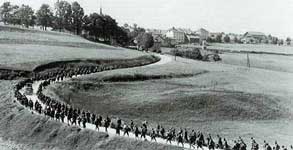
|
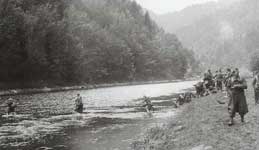
|
|
Crossing River Doub June 1940
|
Internment June 1940
About 12,000 men had escaped, which in doing so placed Switzerland in a precarious position with its Nazi occupied Europe. To minimise political and diplomatic tension with Germany, the Commissaire fédéral à l’internment et hospitalisation decided to construct a mass internment camp at Häftli near Büren in the Canton of Solothurn to partially contain 6,000 Poles and remove local tensions as the Swiss men were away from home defending their border. Up until 10th July 1940 Poles continued to slip over the border by evading German units trying to secure the border. Approximately 500 Polish soldiers from the 1st Grenadier Division had made their way from the Maginot Line and locations in Alsace.
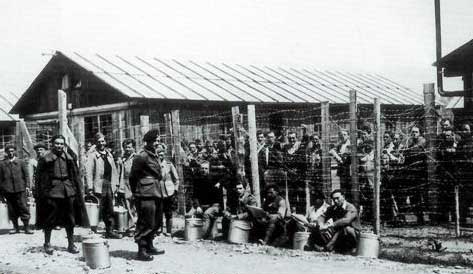
|
|
Source: Fondation Archivum Helveto-Polonicum
|
Nazi Germany had planned to invade Switzerland under operational plan “Tannenbaum” prior to the outbreak of war in Europe. The Swiss under General Henri Guisan had also mobilized civil defence forces such was the threat (Praz, 1995; Falletti, 2007), so the need to keep the Poles activities in check was quite real. Indeed in 1943 the Nazis revised their invasion plans under Operation “Boehme” (Garlinski, 1981). While the authorities employed the Poles on farms, forests and in factories or mines, the relationship settled down after initial tension when in December 1940 riots were quelled and a number of Poles were shot and wounded. Additional camps were built for example at Huttwil and Oberburg and Chavannes de Bogis in the Canton of Vaud to ease pressures with smaller satellite camps spread out throughout Switzerland. Much smaller units sometimes only containing dozens of men were built for local needs, particularly where there were road and bridge construction projects in the mountains.

|
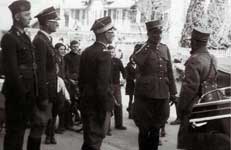
|
|
General Guisan meets Brigadier-General Bronislaw Prugar-Ketling 1941.
|
Switzerland was encircled and under Plan Wahlen all available space was utilized for growing food with the young Poles assisting the Swiss.
The interned Poles were encouraged to return to their studies and many took this option. The Universities of Fribourg and Zurich together with the HEC at St. Gall and a Lycée camp at Wetzikon provided a wide variety of courses, particularly in the sciences and maths. Some faculties had a Swiss dean assisted by a faculty of Polish lecturers all of whom had escaped from the prestigious universities in Poland at the outbreak of war. The academic collaboration was excellent with a Polish-Swiss Commission to oversee the academic awards, which enabled many young Poles to continue their education in the Universities of Applied Sciences (HES).

|
|
Photo kindly donated by Christian Janicki, Canada
|
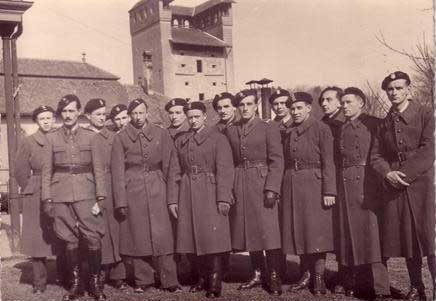
|
Fribourg 1944
Photo kindly donated by Christian Janicki, Canada
|
For others, the farms, mines and forests provided work. Some work details were based in the mountains building roads, bridges and trails that are still in use today. The Poles acted as vital labour to Plan Wahlen and the sustainability of the Swiss economy during the 5 years of internment. By the end of the war the Poles had worked the equivalent of between 7 to 8 million days of labour, constructed 300Km of new roads, repaired and upgraded a further 190 Km, built 65 bridges and repaired another 30. In the mines, the Poles 70,000 tons of iron ore, 7,000 tons of anthracite, 10,000 tons of peat and 7,000 tons of rock for the construction industry. In the forests they had cleared 800 ha of land for forestation and prepared another 600 ha for planting. Rivers were canalized and 500km of telephone lines were installed. For the fruits of their labour they were paid between 1.50 to 5 Chf for piecework, but had to pay for board and lodging.
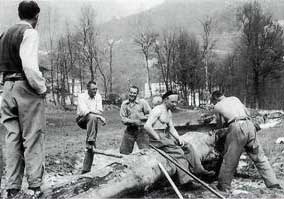
|
|
Source: Fondation Archivum Helveto-Polonicum
|
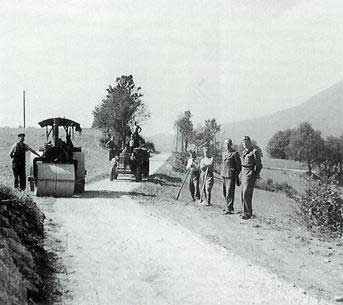
|
|
Source: Fondation Archivum Helveto-Polonicum
|
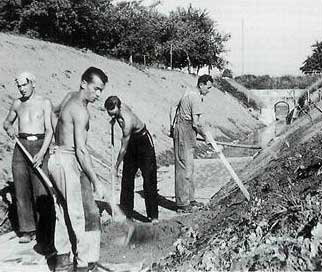
|
|
Source: Fondation Archivum Helveto-Polonicum
|
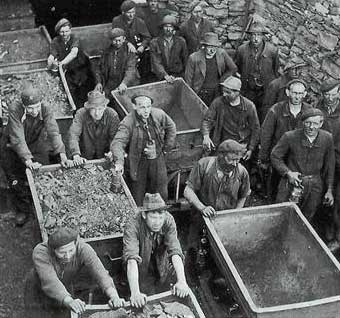
|
|
Source: Fondation Archivum Helveto-Polonicum
|
Spy Networks
Brigadier-General Prugar-Ketling clandestinely remained in contact throughout the war with the Government-in-Exile based in London. He had secret radio contact from bases code named ‘Vera’ and ‘Panorama’. In the first instance the Swiss discouraged the Poles from any form of military activity under the Hague Convention, however, the Swiss secretly recognized the need for the 2DSP to maintain its military standing for discipline and for when the war would be over or needed against Nazi Germany. Once Germany invaded the Soviet Union the Swiss authorities relaxed their control ‘unofficially’ and turned a ‘blind eye’ to Polish activities so long as they were discreet and very secret. In the autumn of 1940 a secret training camp was formed at Thöringen and later at the University of Fribourg, Herisau and at Winterthour where military tactics and theory were taught.

|

|
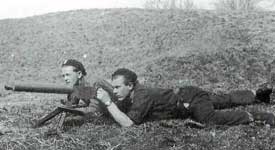
|
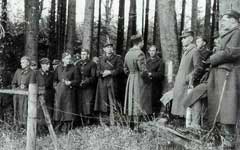
|
|
Source: Fondation Archivum Helveto-Polonicum
|
Training in the forest at Fribourg
Fondation Archivum Helveto-Polonicum
|
As the allies swept through France in late 1944, special units of the 2DSP supported activities with the French resistance (FFI) in the Jura and Haute Savoy. However, the Commander in Chief Kazimierz Sosnkowski ordered all Polish troops to remain in Switzerland. In September 1944 secret evacuations of the 2DSP started from collection points at Illarrsaz, Vevey, Genève and Divonne. Even fisherman on lake Leman assisted in smuggling the Poles to France.
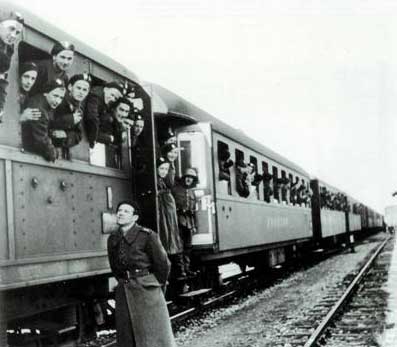
|
Adieu Helvétie !
Source: Fondation Archivum Helveto-Polonicum
|
With the war over the first convoy of interned soldiers left Swiss soil on 22nd November 1945 with the assistance of the Red Cross. Only 2,000 returned to Poland with the majority of about 9,000 returning to France with approximately 1,000 staying in Switzerland to complete their university studies. The residue became scattered around the World.

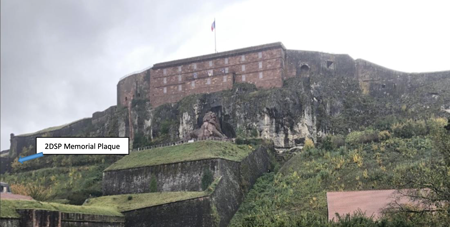

Kindly donated by Steve Gradus
Top of Page
|